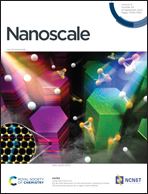Design of nickel cobalt molybdate regulated by boronizing for high-performance supercapacitor applications†
Abstract
Nickel–cobalt-based molybdates have been intensively investigated because of their high theoretical specific capacitance and multifarious oxidation states. Here, we have successfully synthesized hierarchical structures (Ni3B/Ni(BO2)2@NixCoyMoO4) by boronizing NixCoyMoO4 nanosheets on flexible carbon cloth substrates. Benefitting from the synergistic effect among Ni3B, Ni(BO2)2 and NixCoyMoO4 in hybrid architectures, the electrode material possesses higher capacity of 394.7 mA h g−1 at 1 A g−1 and a good rate performance (309.5 mA h g−1 maintained at 20 A g−1). Then, a hybrid supercapacitor assembled with Ni3B/Ni(BO2)2@NixCoyMoO4 and activated carbon as the positive and the negative electrode, displays a high specific capacitance of 370.7 F g−1 at 1 A g−1 (210 F g−1 at 10 A g−1), a high voltage of 1.7 V, and a high energy density of 131.8 W h kg−1 at the power density of 800 W kg−1 (still 74.7 W h kg−1 maintained at 8000 W kg−1). This study widens the research scope of boronizing pseudocapacitance materials and reveals a high application potential of Ni3B/Ni(BO2)2@NixCoyMoO4 for energy storage devices in the future.



 Please wait while we load your content...
Please wait while we load your content...